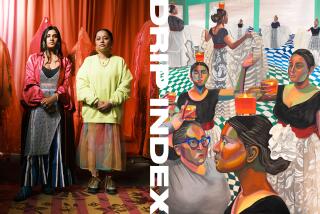Review: This Candy Store wasnât a candy store: Remembering a California gallery that made art stars
The Candy Store never did sell candy. Unable to get permits from the health department in Folsom, Calif., to manufacture her family nougat recipe, Adeliza McHugh pivoted, and instead made art history.
She opened the Candy Store Gallery in 1962 and ran it for 30 years, showcasing a rising generation of artists, mostly based in and around Sacramento and Davis, including soon-to-be luminaries Robert Arneson, Roy De Forest, Gladys Nilsson and Jim Nutt.
Now a show at Parker Gallery in L.A. tells the Candy Storeâs heartening tale with vivid concision. Itâs a delectable tribute, packed with one treat after another.
Arneson sets the tone through a ceramic self-portrait head from 1973, wall-mounted near the entry. Twin reflections of the Candy Storeâs shingled facade gleam from the artistâs sunglasses, supernaturally vibrant against the rest of the figureâs muted, earthy brown. You can almost hear the wry warmth in Arnesonâs voice when he says, via a letter-pressed speech bubble: âWell, fancy seeing you here at the Candy Store Gallery.â
As evidenced by a roomful of archival material â correspondence, snapshots, exhibition announcements â such welcoming informality pervaded McHughâs enterprise. Hers was no sterile white box, nor was the art she gravitated toward coolly minimal or headily conceptual. She decried what she called âKool-Aid artâ that was thin, low-risk and easy to swallow. âIf Iâm going to drink, I want wine,â she said, âand if Iâm going to look at art, itâs got to have a kick.â
Much of the work at Parker was shown at the Candy Store and all of it answers to that description. Nilssonâs 1968 watercolor, âBeing Scared,â is a comic nightmare of grimaces and odd displacements: A tiny blood-red figure wearing green oven mitts and boots scales the scalp of the central character, whose fingers on one hand resemble platypus heads.
In a wondrous landscape drawing in colored pencil and ballpoint pen (1970), Joseph Yoakum articulates a kind of visionary geology, where a band of menâs bare torsos rim a lake.
The intense Fauvist palette of Irving Marcusâ 1967 âBurning Mosque,â in oil pastel and turpentine, isnât all that makes the searing scene jarring and immediate; its subject could have come straight from todayâs headlines.
What McHugh favored was the fantastic, the caustic, the nakedly human, art with an irreverent or whimsical sense of humor, and art with little remove from raw physicality. Ceramics factored heavily in her program, and the examples here are rich and riotous, including a âNose Lampâ (1968) by Clayton Bailey, and a pseudo-ancient stele inscribed with the antics of frogs, elephants and camels by David Gilhooly.
The funk aesthetic that emerged in Northern California in the 1960s and 1970s, as defined by artist Jim Melchert, derived in part from the realization that we are all, in essence, animals. That awareness surfaces regularly here, in works where humans and beasts hybridize, with interchanging body parts and characteristics. Like the Candy Store Gallery itself, the art it championed was surprising, fresh and delightfully audacious.
Parker Gallery, 2441 Glendower Ave., L.A. Through Aug. 11; closed Sundays-Wednesdays. (213) 631-1343, www.parkergallery.com
See all of our latest arts news and reviews at latimes.com/arts.
More to Read
The biggest entertainment stories
Get our big stories about Hollywood, film, television, music, arts, culture and more right in your inbox as soon as they publish.
You may occasionally receive promotional content from the Los Angeles Times.










